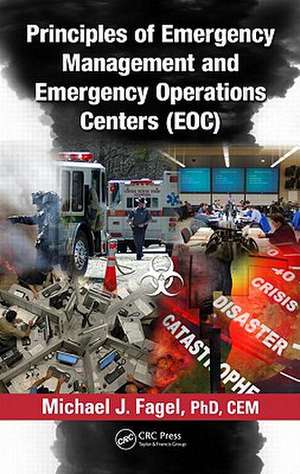Principles of Emergency Management and Emergency Operations Centers (EOC)
Autor Michael J. Fagelen Limba Engleză Hardback – 8 dec 2010
The book details the requirements for appropriate training and planning, both validated by a well-designed exercise program. Stressing the importance of consistency with the various national preparedness initiatives, it includes the latest developments and best practices in the evolving field of emergency management.
Preț: 834.63 lei
Preț vechi: 917.18 lei
-9% Nou
Puncte Express: 1252
Preț estimativ în valută:
159.76€ • 173.59$ • 134.28£
159.76€ • 173.59$ • 134.28£
Carte tipărită la comandă
Livrare economică 21 aprilie-05 mai
Preluare comenzi: 021 569.72.76
Specificații
ISBN-13: 9781439838518
ISBN-10: 1439838518
Pagini: 406
Ilustrații: 61 black & white illustrations, 76 black & white tables
Dimensiuni: 169 x 239 x 27 mm
Greutate: 0.72 kg
Editura: CRC Press
ISBN-10: 1439838518
Pagini: 406
Ilustrații: 61 black & white illustrations, 76 black & white tables
Dimensiuni: 169 x 239 x 27 mm
Greutate: 0.72 kg
Editura: CRC Press
Public țintă
Fire chiefs and personnel; local, state and federal emergency managers, students in emergency management, fire science, and life safety, response forces in the following agencies: USEP A, FEMA, DoD, USDA, DOE, NOAA, DHHS, DOJ, DO.Cuprins
Introduction; Michael Fagel and Stephen Krill
Types of Disasters
Phases of Disaster
Levels of Severity
Why Plans Fail
Planning As a Blueprint
A Brief History of Emergency Management
Authorities and Directives
Response Plans
Assessing Vulnerabilities; James Peerenboom and Ron Fisher
Vulnerability Assessment
Critical Infrastructure and Key Resources (CIKR)
Methodological Approaches to Vulnerability Assessment
Simple Rating
Risk Matrix
Risk Equation
Required Expertise
Developing a Planning Team; Michael Fagel
The Emergency Planning Team
Who Should Be on the Planning Team?
Getting the Team Together
Team Operation
Stages of Team Formation
Team Roles
Characteristics of an Effective Team
Responder Health and Safety; Michael Steinle
Defining Essential Personnel
Response Scenarios and Associated Hazards
Protection Programs and Systems
Medical Protective Practices
Disaster Preparedness and the Law; Thomas Schneid
The Questions
The Answers
The Potentially Applicable Laws
Negligence
Emergency Management Phases
Stress Management and Responders; K. R. Juzwin
Why Stress Management Is Important to Emergency Managers
Stress-Related Disorders
Understanding Stress along the Continuum
Stress Reactions
Acute Stress
Manager Responsibilities in a Critical Event
Planning: Helping Take Care of Your Responders in Advance
Suggestions for Supporting Your Responders
Psychological First Aid
Critical Incident Stress Management (CISM)
Briefing and Debriefing
Suggestions and Considerations
Developing an Emergency Operations Plan (EOP); Michael Fagel
Why a Jurisdiction Needs an EOP
The Emergency Planning Process
Components of an Emergency Operations Plan
The Emergency Planning Team
Disaster Preparedness and the Law
Developing an Exercise Program; Michael Fagel
Why Exercise?
Regulatory Requirements
Exercise Functions
The Comprehensive Exercise Program
Who Participates in the Exercise Program?
Activities Included in the Exercise Program
Building an Exercise Program
The Exercise Process
Reviewing the Current Plan
Assessing Capability to Conduct an Exercise
Addressing Liabilities and Costs
Gaining Support
Assembling a Design Team
Exercise Documents
Three Types of Exercises; Michael Fagel
The Functional Exercise
The Full-Scale Exercise
Exercise Evaluation
Postexercise Briefings
Enhancements
EOC Management and Operations; Lucien Canton and Nicholas Staikos
Facility Management
Operational Management
Organizing for EOC Management
Operations Room Design
ICS/EOC Interface; Michael Fagel|
EOC Management and Operations: Responsibilities
Foundations for Establishing the Emergency Operations Center
Using the EOP and Hazard Analysis to Design an EOC
Developing Policies and Procedures
Continuity of Operations Planning; Chad Bowers
The Foundation: Continuity Planning and Program Management
Continuity Program Management Cycle
Essential Functions
Human Capital
Continuity Teams and Leadership
Orders of Succession
Delegations of Authority
Primary Facilities
Alternate Facilities
Vital Records/Vital Resources
Devolution
Reconstitution
Testing, Training, and Exercising
The Role of Business Continuity Management; Robert Coullahan
Context and Challenge: Critical Infrastructure Protection
National Infrastructure Protection Plan (NIPP)
Sector-Specific Plans
Role of the Private Sector in Contemporary Emergency Operations
Professional Practices of Business Continuity Management
Enterprise Resilience
Emergency Command Center: Mission, Roles, and Responsibilities
Relationship with the Public Safety EOC
Emerging Capabilities: State and Local Data Fusion Centers
PublicߝPrivate Partnerships
Appendices:
Organizing for Homeland Security and Emergency Management; Stephen Krill
Managing Spontaneous Volunteers; Michael Fagel
Emergency Management and the Media; Randall Duncan
Types of Disasters
Phases of Disaster
Levels of Severity
Why Plans Fail
Planning As a Blueprint
A Brief History of Emergency Management
Authorities and Directives
Response Plans
Assessing Vulnerabilities; James Peerenboom and Ron Fisher
Vulnerability Assessment
Critical Infrastructure and Key Resources (CIKR)
Methodological Approaches to Vulnerability Assessment
Simple Rating
Risk Matrix
Risk Equation
Required Expertise
Developing a Planning Team; Michael Fagel
The Emergency Planning Team
Who Should Be on the Planning Team?
Getting the Team Together
Team Operation
Stages of Team Formation
Team Roles
Characteristics of an Effective Team
Responder Health and Safety; Michael Steinle
Defining Essential Personnel
Response Scenarios and Associated Hazards
Protection Programs and Systems
Medical Protective Practices
Disaster Preparedness and the Law; Thomas Schneid
The Questions
The Answers
The Potentially Applicable Laws
Negligence
Emergency Management Phases
Stress Management and Responders; K. R. Juzwin
Why Stress Management Is Important to Emergency Managers
Stress-Related Disorders
Understanding Stress along the Continuum
Stress Reactions
Acute Stress
Manager Responsibilities in a Critical Event
Planning: Helping Take Care of Your Responders in Advance
Suggestions for Supporting Your Responders
Psychological First Aid
Critical Incident Stress Management (CISM)
Briefing and Debriefing
Suggestions and Considerations
Developing an Emergency Operations Plan (EOP); Michael Fagel
Why a Jurisdiction Needs an EOP
The Emergency Planning Process
Components of an Emergency Operations Plan
The Emergency Planning Team
Disaster Preparedness and the Law
Developing an Exercise Program; Michael Fagel
Why Exercise?
Regulatory Requirements
Exercise Functions
The Comprehensive Exercise Program
Who Participates in the Exercise Program?
Activities Included in the Exercise Program
Building an Exercise Program
The Exercise Process
Reviewing the Current Plan
Assessing Capability to Conduct an Exercise
Addressing Liabilities and Costs
Gaining Support
Assembling a Design Team
Exercise Documents
Three Types of Exercises; Michael Fagel
The Functional Exercise
The Full-Scale Exercise
Exercise Evaluation
Postexercise Briefings
Enhancements
EOC Management and Operations; Lucien Canton and Nicholas Staikos
Facility Management
Operational Management
Organizing for EOC Management
Operations Room Design
ICS/EOC Interface; Michael Fagel|
EOC Management and Operations: Responsibilities
Foundations for Establishing the Emergency Operations Center
Using the EOP and Hazard Analysis to Design an EOC
Developing Policies and Procedures
Continuity of Operations Planning; Chad Bowers
The Foundation: Continuity Planning and Program Management
Continuity Program Management Cycle
Essential Functions
Human Capital
Continuity Teams and Leadership
Orders of Succession
Delegations of Authority
Primary Facilities
Alternate Facilities
Vital Records/Vital Resources
Devolution
Reconstitution
Testing, Training, and Exercising
The Role of Business Continuity Management; Robert Coullahan
Context and Challenge: Critical Infrastructure Protection
National Infrastructure Protection Plan (NIPP)
Sector-Specific Plans
Role of the Private Sector in Contemporary Emergency Operations
Professional Practices of Business Continuity Management
Enterprise Resilience
Emergency Command Center: Mission, Roles, and Responsibilities
Relationship with the Public Safety EOC
Emerging Capabilities: State and Local Data Fusion Centers
PublicߝPrivate Partnerships
Appendices:
Organizing for Homeland Security and Emergency Management; Stephen Krill
Managing Spontaneous Volunteers; Michael Fagel
Emergency Management and the Media; Randall Duncan
Recenzii
A true professional, Mike Fagel arrived at FDNY WTC Incident Command Post on Duane Street, a short distance from Ground Zero, as chaos was still not contained. He organized, directed, and cajoled until order again appeared in our health and safety efforts for the thousands of personnel struggling at rescuing and recovering the victims of 9/11. Many of the Ground Zero workers have their health still intact because of Mike’s courage and efforts. The Fire Department was well served by his knowledge and expertise.
—Charles R. Blaich, Deputy Chief FDNY, & Logistics Chief, WTC ICP
… an essential tool that should be in every new emergency manager’s tool belt and on every seasoned emergency manager’s reference shelf.
—Rick C. Mathews, MS, Director of the National Center for Security & Preparedness
This is a thorough text on the disaster cycle planning and implementation-from assessing vulnerabilities to stress management to exercises to emergency operations center operations and management. ... a comprehensive, on-the-ground operational text for emergency managers.
—Natural Hazards Observer
—Charles R. Blaich, Deputy Chief FDNY, & Logistics Chief, WTC ICP
… an essential tool that should be in every new emergency manager’s tool belt and on every seasoned emergency manager’s reference shelf.
—Rick C. Mathews, MS, Director of the National Center for Security & Preparedness
This is a thorough text on the disaster cycle planning and implementation-from assessing vulnerabilities to stress management to exercises to emergency operations center operations and management. ... a comprehensive, on-the-ground operational text for emergency managers.
—Natural Hazards Observer
Notă biografică
Michael J. Fagel, Ph.D., CEM, has more than 40 years of experience in emergency management, including ten years as a Disaster Safety Officer with the Federal Emergency Management Agency (FEMA) and the Department of Homeland Security (DHS). During his career he has been been involved in fire service, emergency medical service, public health, law enforcement and emergency management, bio-terrorism awareness and prevention, as well as corporate safety, security and threat risk management.
He served as an officer on the North Aurora Fire Department for over 28 years and in that time served as the EMS Coordinator and the Emergency Management Agency director. He was a responder to many federally declared emergencies, including deployment to Oklahoma City Bombing in 1995 and World Trade Center Attacks in 2001. He has provided WMD instruction to managers at federal facilities nationwide for the U.S. Army, as well as providing technical support to state and county agencies on the CDC’s SNS Planning. He has served as a subject matter expert for the National Guard Bureau AEAS and provided national EOC planning and CONOPS for the USA and Middle East venues, including EOC support at the Salt Lake City Olympics. He was a team leader at the Louisiana State University’s National Center for Bio Medical Research and Training (NCBRT) in their Response to Agricultural Terrorism Training Program, as well as their Public Health Programs in Response to High Consequence Events.
Currently, he teaches at the University of Chicago in their Masters of Threat Response Management Program. He also teaches Bio Defense/Homeland Security at Northwestern University in Chicago in their Master of Arts in Public Policy and Administration program, as well at Benedictine University in the Masters in Public Health program, and Eastern Kentucky University in their Safety Security Emergency Management Masters program. He is a guest lecturer for many universities and organizations nationwide, including being a subject matter expert (SME) for the National Center for Security and Preparedness (NCSP) at the University at Albany, State University of New York. Fagel is also currently a Homeland Security Analyst at the Argonne National Laboratory engaged in the protection of Critical Infrastructure.
He is a member of the Northern Illinois Critical Incident Stress Debriefing team, the International Association of Fire Chiefs Committee on Safety and Health, as well as their Terrorism Committee. He served on the Illinois Terrorism Task Force, and was the Region V President for the International Association of Emergency Managers (IAEM), and was a vice-chairman for the Certified Emergency Manager Commissioner (CEM) for IAEM. He is the IAEM liaison to USDA/FDA and the International Association of Fire Chiefs (IAFC).
He has published hundreds of articles, two textbooks on Emergency Management, and been a contributing editor to several industry journals. He has been a chapter contributor for textbooks written by IAEM, National Fire Protection Association (NFPA), and National Safety Council (NSC), as well as others.
He served as an officer on the North Aurora Fire Department for over 28 years and in that time served as the EMS Coordinator and the Emergency Management Agency director. He was a responder to many federally declared emergencies, including deployment to Oklahoma City Bombing in 1995 and World Trade Center Attacks in 2001. He has provided WMD instruction to managers at federal facilities nationwide for the U.S. Army, as well as providing technical support to state and county agencies on the CDC’s SNS Planning. He has served as a subject matter expert for the National Guard Bureau AEAS and provided national EOC planning and CONOPS for the USA and Middle East venues, including EOC support at the Salt Lake City Olympics. He was a team leader at the Louisiana State University’s National Center for Bio Medical Research and Training (NCBRT) in their Response to Agricultural Terrorism Training Program, as well as their Public Health Programs in Response to High Consequence Events.
Currently, he teaches at the University of Chicago in their Masters of Threat Response Management Program. He also teaches Bio Defense/Homeland Security at Northwestern University in Chicago in their Master of Arts in Public Policy and Administration program, as well at Benedictine University in the Masters in Public Health program, and Eastern Kentucky University in their Safety Security Emergency Management Masters program. He is a guest lecturer for many universities and organizations nationwide, including being a subject matter expert (SME) for the National Center for Security and Preparedness (NCSP) at the University at Albany, State University of New York. Fagel is also currently a Homeland Security Analyst at the Argonne National Laboratory engaged in the protection of Critical Infrastructure.
He is a member of the Northern Illinois Critical Incident Stress Debriefing team, the International Association of Fire Chiefs Committee on Safety and Health, as well as their Terrorism Committee. He served on the Illinois Terrorism Task Force, and was the Region V President for the International Association of Emergency Managers (IAEM), and was a vice-chairman for the Certified Emergency Manager Commissioner (CEM) for IAEM. He is the IAEM liaison to USDA/FDA and the International Association of Fire Chiefs (IAFC).
He has published hundreds of articles, two textbooks on Emergency Management, and been a contributing editor to several industry journals. He has been a chapter contributor for textbooks written by IAEM, National Fire Protection Association (NFPA), and National Safety Council (NSC), as well as others.










